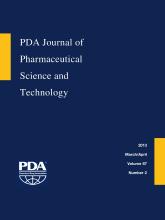Abstract
The workshop was held on 27 June 2011 in Barcelona, in conjunction with the PDA Virus & TSE (transmissible spongiform encephalopathy) Safety Forum 2011.
Virus-retentive filters are important tools to assure a high virus safety level of biological medicinal products. Important parameters such as properties of virus spike preparations, mechanism of virus retention by different filter brands, use of prefilters to improve the filtration performance, and, finally, strategies to select the most appropriate filter for a specific product were discussed on the workshop. The panel discussion at the end of the workshop that involved speakers and regulators from different global areas came to following conclusions:
The major mechanism of virus retention is size exclusion; filtration, however, is complex and protein and virus can interact with the membrane in multiple ways. Pressure interruption during filtration resulted in enhanced virus passage.
It has never been reported that murine leukemia virus (MuLV) passes a parvovirus filter. It makes sense that a small virus can be used to provide a claim for a large virus like MuLV. This relies on the assumption that there is no aggregation or interaction of the model parvovirus with proteins leading to aggregates larger than retroviruses.
Several prefilters are under investigation to improve flow rate and throughput of filtration in large-scale manufacture. It was discussed whether the prefilter and the virus-retentive filter can be viewed as one unit operation so that virus retention by both can be claimed as the viral clearance capacity of this manufacturing step. This question engendered some controversy: whereas some saw the combination as a correct reflection of manufacturing conditions, others discussed the different mechanisms of virus retention, which need to be studied separately.
All together, the workshop was seen as a valuable forum for the discussion between regulators and industry; it was proposed that such forum should be provided again if possible in connection with one of the next PDA Virus & TSE Safety Conferences.
LAY ABSTRACT: The workshop was held on 27 June 2011 in Barcelona, in conjunction with the PDA Virus & TSE (transmissible spongiform encephalopathy) Safety Forum 2011.
Virus-retentive filters are important tools to assure a high virus safety level of biological medicinal products. Important parameters such as properties of virus spike preparations, mechanism of virus retention by different filter brands, use of prefilters to improve the filtration performance and, finally, strategies to select the most appropriate filter for a specific product were discussed on the workshop. At the end of the workshop, aspects of the discussion were summarized by the following:
The major mechanism of virus retention is size exclusion, but interactions are complex. Pressure interruption during filtration resulted in enhanced virus passage.
It has never been reported that murine leukemia virus (MuLV) passes a parvovirus filter, and thus the parvovirus may provide a claim for a large virus like MuLV.
Combination of prefilter and the virus-retentive filter are seen by some panelists as a correct reflection of manufacturing conditions; others discussed the different mechanisms of virus retention, which need to be studied separately.
All together, the workshop was seen as a valuable forum for the discussion between regulators and industry.
- © PDA, Inc. 2013
PDA members receive access to all articles published in the current year and previous volume year. Institutional subscribers received access to all content. Log in below to receive access to this article if you are either of these.
If you are neither or you are a PDA member trying to access an article outside of your membership license, then you must purchase access to this article (below). If you do not have a username or password for JPST, you will be required to create an account prior to purchasing.
Full issue PDFs are for PDA members only.
Note to pda.org users
The PDA and PDA bookstore websites (www.pda.org and www.pda.org/bookstore) are separate websites from the PDA JPST website. When you first join PDA, your initial UserID and Password are sent to HighWirePress to create your PDA JPST account. Subsequent UserrID and Password changes required at the PDA websites will not pass on to PDA JPST and vice versa. If you forget your PDA JPST UserID and/or Password, you can request help to retrieve UserID and reset Password below.






